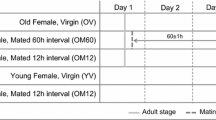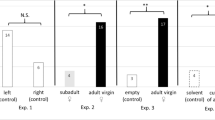Abstract
Mate recognition is essential to reproductive success especially under sympatry where encounters between the sexes of different species is likely. We examined the response of male ant-mimicking salticid spiders of the genus Myrmarachne and of five different color forms to retreat and dragline silks of sympatric females of six color forms to determine whether silk-based cues could be used as pre-mating isolation mechanisms and aid species determination. We found evidence for polymorphism within one species Myrmarachne plataleoides, a well-known mimic of the weaver ant Oecophylla smaragdina. Male color morphs of this species showed cross-interest in female silks of other color morphs of this species, but also exhibited greatest preference for the silk of their own color morph, providing evidence for assortative mating and the possibility of silk-based cues as mechanisms of incipient speciation via disruptive selection. Males of two other color forms exhibited unambiguous preference for the silk of their own color forms, suggesting that these two forms are distinct species. The silk-based findings were confirmed by no-choice mating experiments and opportunistic observations of natural matings.





Similar content being viewed by others
References
Arnegard ME, Kondrashov AS (2004) Sympatric speciation by sexual selection alone is unlikely. Evolution 58:222–237
Bhattacharya GC (1939) On the moulting and metamorphosis of Myrmarachne plataleoides. Trans Bose Res Inst 12:103–114
Bukowski TC, Linn CD, Christenson TE (2001) Copulation and sperm release in Gasteracantha cancriformis (Araneae: Araneidae): differential male behaviour based on female mating history. Anim Behav 62:887–895
Clark DL, Jackson RR (1995) Dragline-mediated sex recognition in two species of jumping spiders (Araneae Salticidae) Portia labiata and P. fimbriata. Ethol Ecol Evol 7:73–77
Coyne JA, Orr HA (2004) Speciation, Sinauer, Sunderland, Massachusetts
Cutler B (1980) Synemosyna bicolor is the female of Synemosyna americana (Araneae, Salticidae). J Arachnol 9:342–343
Dieckmann U, Doebeli M (1999) On the origin of species by sympatric speciation. Nature 400:123–130
Elgar MA (1998) Sperm competition and sexual selection in spiders and other arachnids. In: Birkhead TR, Møller AP (eds) Sperm Competition and Sexual Selection, Academic Press, San Diego, pp 307–332
Etges WJ (2002) Divergence in mate choice systems: does evolution play by rules? Genetica 116:151–166
Gray SM, McKinnon JS (2007) Linking color polymorphism maintenance and speciation. Trends Ecol Evol 22:71–79
Jackson RR (1986) Cohabitation of males and juvenile females: a prevalent mating tactic of spiders. J Nat Hist 20:1193–1210
Jackson RR (1987) Comparative study of releaser pheromones associated with the silk of jumping spiders (Araneae, Salticidae). New Zealand J Zool 14:1–10
Jiggins CD, Estrada C, Rodrigues A (2004) Mimicry and the evolution of premating isolation in Heliconius melpomene Linnaeus. J Evol Biol 17:680-691
Jiggins CD, Emelianov I, Mallet J (2005) Assortative mating and speciation as pleiotropic effects of ecological adaptation: examples from moths and butterflies. In: Fellowes M, Holloway G, Rolff (eds) Insect Evolutionary Ecology, Proceedings of the Royal Entomological Society’s 22nd Symposium, CABI Publishing, pp 451–473
Joron M, Mallet JLB (1998) Diversity in mimicry: paradox or paradigm. Trends Ecol Evol 13:461–466
Kirkpatrick M, Ravigné V (2002) Speciation by natural and sexual selection: models and experiments. Am Nat 159:S22–S35
Korol A, Rashkovetsky E, Iliadi K, Michalak P, Ronin Y, Nevo E (2000) Nonrandom mating in Drosophila melanogaster laboratory populations derived from closely adjacent ecologically contrasting slopes at “Evolution Canyon”. Proc Natl Acad Sci USA 97:12637–12642
Linn CL Jr, Feder JL, Nojima S, Dambroski HR, Berlocher SH, Roelofs W (2003) Fruit odor discrimination and sympatric host race formation in Rhagoletis. Proc Natl Acad Sci USA 100:11490–11493
Maelfait J-P, de Keer R, de Meester L (1990) Genetical background of the polymorphism of Oedothorax gibbosus (Blackwall) (Linyphiidae, Araneae). Rev Arachnol 9:29–34
Mallet J (1995) A species definition for the modern synthesis. Trends Ecol Evol 10:294–299
Mallet J, Joron M (1999) Evolution of diversity in warning color and mimicry: polymorphisms, shifting balance, and speciation. Annu Rev Ecol Syst 30:201–233
Mallet J, McMillan WO, Jiggins CD (1998) Mimicry and warning color at the boundary between race and species. In: Howard DJ, Berlocher SH (eds) Endless Forms, Species and Speciation, Oxford University Press, New York and Oxford, pp 390–403
Naisbit RE, Jiggins CD, Mallet J (2003) Mimicry: developmental genes that contribute to speciation. Evol Dev 5:269–280
Oxford GS, Gillespie RG (1998) Evolution and ecology of spider coloration. Annu Rev Entomol 43:619–643
Pollard SD (1994) Consequences of sexual selection on feeding in male jumping spiders (Araneae: Salticidae). J Zool 234:203–208
Reiskind J (1965) The taxonomic problem of sexual dimorphism in spiders and a synonymy in Myrmecotypus (Araneae, Clubionidae). Psyche 72:279–281
Reiskind J (1970) Multiple mimetic forms in an ant-mimicking clubionid spider. Science 169:587–588
Roberts AJ, Uetz GW (2004) Species-specificity of chemical signals: silk source affects discrimination in a wolf spider (Araneae: Lycosidae). J Insect Behav 17:477–491
Rueffler C, Van Dooren TJM, Leimar O, Abrams PA (2006) Disruptive selection and then what? Trends Ecol Evol 21:238–245
Schäfer MA, Uhl G (2002) Determinants of paternity success in the spider Pholcus phalangioides (Pholcidae: Araneae): the role of male and female mating behaviour. Behav Ecol Sociobiol 51:368–377
Seehausen O, van Alphen JJM, Lande R (1999) Color polymorphism and sex ratio distortion in a cichlid fish as an incipient stage in sympatric speciation by sexual selection. Ecol Lett 2:367–378
Singh SR, Rashkovetsky E, Iliadi K, Nevo E, Korol A (2005) Assortative mating in Drosophila adapted to a microsite ecological gradient. Behav Gen 35:753–764
Sword GA (1999) Density-dependent warning coloration. Nature 397:217
Talwar M, Zacharias M, Gowda V, Kapoor V, Raychaudhuri S, Sridhar H, Lokhandwala Z, Borges RM (2001) Understanding ant-avoidance behaviours in the myrmecomorphic spider Myrmarachne plataleoides, mimic of the weaver ant Oecophylla smaragdina. In: Ganeshaiah KN, Uma Shaanker R, Bawa KS (eds) Tropical Ecosystems: Structure, Diversity and Human Welfare, Oxford-IBH, New Delhi, pp 649–653
van Doorn GS, Weissing FJ (2001) Ecological versus sexual selection models of sympatric speciation: a synthesis. Selection 2:17–40
Vane-Wright RI, Bopré M (1993) Visual and chemical signalling in butterflies: functional and phylogenetic perspectives. Phil Trans R Soc London B 340:197–205
Yoshida H, Suzuki Y (1981) Silk as a cue for mate location in a jumping spider Carrholtus xanthogrammus (Latreille) (Araneae, Salticidae). Appl Entomol Zool 16:315–317
Acknowledgments
This research was funded by grants from the Council of Scientific and Industrial Research and the Ministry of Environment and Forests, Government of India. We thank the Jawaharlal Nehru Centre for Advanced Scientific Research, Bangalore, for permission to collect spiders from its campus, and the anonymous reviewers for constructive suggestions on the manuscript.
Author information
Authors and Affiliations
Corresponding author
Rights and permissions
About this article
Cite this article
Borges, R.M., Ahmed, S. & Prabhu, C.V. Male Ant-mimicking Salticid Spiders Discriminate Between Retreat Silks of Sympatric Females: Implications for Pre-mating Reproductive Isolation. J Insect Behav 20, 389–402 (2007). https://doi.org/10.1007/s10905-007-9085-0
Published:
Issue Date:
DOI: https://doi.org/10.1007/s10905-007-9085-0




